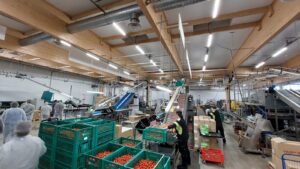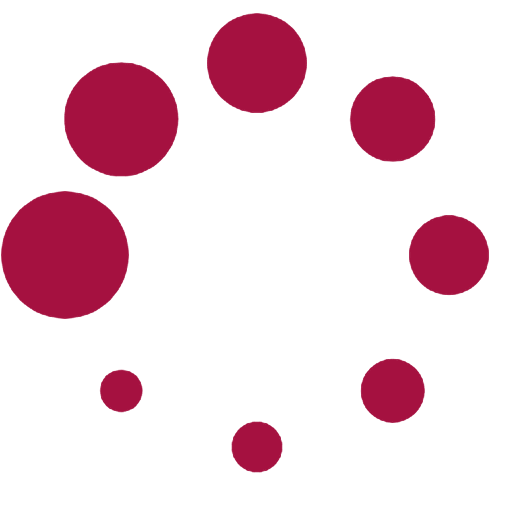The Greenhouse Vegetables Team at Delphy embarks on an annual journey to an intriguing destination to gain insights and explore the latest industry developments. This year, Finland was the destination, where the team visited three leading growers and a pioneering growers’ cooperative. In the horticultural area of Närpes, they gained an understanding of the unique challenges and innovations within the Finnish greenhouse sector.
Horticulture in Närpes: A focus on food production
Driving from Vaasa to Närpes, it’s immediately evident that food production is at the heart of this region. Tomatoes and cucumbers are predominant here, supplemented by peppers and, to a lesser extent, eggplants. These crops are primarily cultivated for the Finnish domestic market. The average greenhouse size is 1.35 hectares, relatively small compared to the Netherlands. Nevertheless, growers achieve impressive efficiency through intensive lighting, ranging from 400 to 650 µmol.
Increasing use of full-LED and flexible systems 
An interesting trend is the growing adoption of Full-LED lighting, now accounting for 11% of lit cultivation areas. Most growers employ hybrid systems (61%), while 28% still rely solely on HPS lighting. Unlike in the Netherlands, the use of light emission screens is not mandatory in Finland. In fact, the extra light is appreciated by the local population during the dark winter months, when daylight is scarce.
Moisture management in extreme conditions
Despite the extreme cold outside, dehumidification is becoming increasingly popular in Finnish greenhouses. Venting moisture through roof windows poses a significant challenge, especially with high light intensities. Dehumidification systems are an effective solution and are being increasingly adopted to maintain balanced humidity levels.
Unique advantages of the finnish climate
The harsh winter climate also brings benefits. Pest pressure from the outside is relatively low. If pests do enter the greenhouse, the risks remain limited due to the significant distances between farms, minimizing the likelihood of cross-contamination.
These insights demonstrate how Finland serves as an inspiring example of how local conditions and technological innovations work together to achieve efficient and sustainable production. For the Delphy team, the trip was an educational experience filled with valuable knowledge that will undoubtedly contribute to their practices in the Netherlands.
Visit 1: Sigg-Plant – Vegetable plant nursery on 4.2 hectares
Sigg-Plant, an impressive vegetable plant nursery, specializes in cultivating tomato (50%), cucumber (45%), and pepper plants (5%). Hygiene, quality, and automation are central here. The process is so streamlined that the plants are only handled when it’s time to stake them in pots. Until then, they remain untouched, minimizing hygiene risks. Even plant transport is well thought out: they are delivered in cardboard boxes, which is both practical and hygienic. This eliminates the need to retrieve reusable containers later.
Sigg-Plant exports plants to various countries, including Finland, Germany, Denmark, Poland, Norway, Sweden, Estonia, and Latvia. The farthest customer is located in Hamburg. During transport, temperatures are strictly controlled. In Finland, cultivation is predominantly done on rockwool.
Visit 2: Johan Prinsén – High-tech cucumber and tomato cultivation
At Johan Prinsén’s operation, innovation is key in a fully LED-lit greenhouse. Lighting includes 505 µmol overhead and 75 µmol interlight. The operation achieves three growing cycles per year, utilizing new rockwool slabs and thorough sanitation between cycles. This minimizes disease risk and ensures high yields, with a target of 235 kilograms per square meter.
A unique feature is the fully automated bag system, which significantly reduces labor as plant stems are coiled onto hooks. For cucumbers, no thinning of fruits is performed, resulting in up to 16 quality fruits per stem. The first fruit is retained after the fifth leaf.
While the results are impressive, challenges such as humidity persist. A trial with dehumidifiers has been ongoing for a month to address this.
Visit 3: Martin and Jonathan Sigg – Full-LED tomatoes and peppers
Martin and Jonathan Sigg utilize a fully LED-lit greenhouse for growing tomatoes and sweet pointed peppers on a substrate of moss wool mixed with wood chips. Tomato varieties like Gerdicia (loose tomatoes) and Ardiles are grown under 500 µmol light without far-red light.
For peppers (Palermo variety), the growing cycle runs from July to May with 250 µmol light, 10% of which is far-red. Innovative techniques, such as using tomato hooks to lower plants and prevent them from touching the glass, are employed.
Visit 4: Närpes Grönsaker – Cooperative focused on quality and branding
Närpes Grönsaker is a cooperative of 34 growers with a combined production of 46 hectares of greenhouse vegetables, 33 of which are lit. The cooperative focuses on the domestic market but is expanding its reach into Sweden.
Branding and quality are central to their strategy. Ten years ago, only 6% of Finnish consumers recognized their brand; today, this figure stands at 83%. This success stems from extensive market research and close collaboration with supermarkets. There is now growing demand for specialty tomatoes, compared to 99% bulk production in the past, which has decreased to 52%.
Finnish consumers are willing to pay a premium for local products. Winter tomato prices reach €5.50 per kilogram, and cucumbers cost around €4 per kilogram in supermarkets. Major retailers such as SOK, Kesko, Pirkka, and Lidl are key partners, catering to the demand for greater transparency: 50% of customers want detailed packaging information.

Round tomatoes
- Varieties: Livento and Gerdicia
- Traditional cultivation: 45 kg/m²/year
- Illuminated cultivation: 84 kg/m²/year
Cherry tomatoes
- Varieties: Conchita (traditional cultivation) and Chiretto (exposed cultivation)
- Traditional cultivation: 25 kg/m²/year
- Illuminated cultivation: 45 kg/m²/year
Red and orange mini plum tomatoes
- Varieties: Sweetelle and Bamano
- Traditional cultivation: 16 kg/m²/year
- Illuminated cultivation: 30 kg/m²/year
Cucumbers
- Varieties: Imea and Kyra
- Cultivation method: lit only
- Average production: 180 kg/m²/year
Sweet peppers
- Varieties: Alzamora, Maureno (red block peppers), San-Siro (yellow block peppers), Palermo (pointed peppers)
- Traditional cultivation:
- Red and yellow block peppers: 17 kg/m²/year
- Palermo
- Exposed cultivation:
- Palermo: 20 kg/m²/year
Energy use in finnish greenhouse horticulture: Trends and challenges
The Finnish greenhouse sector demonstrates how growers adapt to dynamic energy prices and the shift towards more sustainable energy sources. The use of e-boilers is on the rise, driven by fluctuating energy costs. Growers are seeking flexible solutions to manage peaks and troughs in costs, with electric heat generation gaining popularity.
Energy diversity
Finland’s energy supply is diverse, utilizing both renewable and fossil sources:
- 37% from peat blocks, a traditional but controversial source.
- 29% from wood chips and 22% from wood and construction materials.
- Fossil fuels play a minor role, with natural gas at 6%, fuel oil at 2%, and heavy oil at 1%.
Electricity: Largely CO2-free
About 50% of Finland’s electricity comes from renewables like hydropower, wind, and solar. Combined with nuclear energy, 76% of electricity is CO2-free. This provides growers with stable and sustainable electricity options, essential for lit cultivation.
Cost overview
Electricity costs in Finland range between €0.03 and €0.055 per kWh, excluding transport fees of €0.02 to €0.025 per kWh. While competitive, transport fees remain a significant factor.
Conclusion
The visited locations highlight how innovation, hygiene, and branding shape the future of greenhouse horticulture. From smart transport solutions and full-LED lighting to advanced marketing strategies, each visit showcased a different aspect of a constantly evolving sector.


